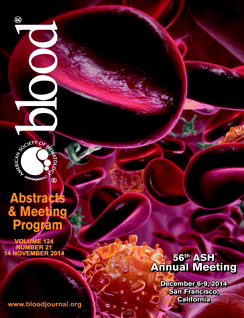Abstract
Introduction: Phase 2 single agent trials with lenalidomide and panobinostat in patients with relapsed or refractory HL have demonstrated overall response rates (ORR) of 19% (Fehniger et al., Blood 118:5119-5125, 2011) and 27% (Younes et al., JCO 30:2197-2203, 2012), respectively. We conducted a phase I/II trial to determine the dose limiting toxicity (DLT), maximum tolerated dose (MTD), and overall response rate (ORR) with combined lenalidomide and panobinostat in patients with relapsed HL.
Methods: Patients with relapsed or refractory classical HL (cHL) or lymphocyte predominant HL (LP HL) after at least one prior therapy were eligible. Measurable disease > 1 cm, ejection fraction ≥ 45%, ECOG PS 0-2, QTc ≤ 450 msec, ANC ≥ 1200/mm3, platelets ≥ 100,000/mm3, AST/ALT ≤ 2.5 x the upper limit of normal (ULN), bilirubin ≤ 1.5 x ULN, and creatinine clearance 60 ≥ ml/min were also required. In the phase I trial, escalating doses of panobinostat (15 or 20 mg) days 1, 3, and 5 weekly were combined with lenalidomide 25 mg days 1-21 utilizing a 3+3 standard dose escalation design. DLT was defined during cycle 1 as grade 4 neutropenia or thrombocytopenia, grade 4 infection, grade 3 infection for > 7 days, treatment delays > 14 days, or other grade 3-4 non-hematologic toxicity. Twenty-eight days defined a cycle and patients could remain on therapy until disease progression. Response was assessed after cycles 2, 6, and every 4 cycles thereafter by International Harmonization Criteria (Cheson, JCO 25:579-586, 2007).
Results: From Feb 2012 through June 2014, 22 patients (16 males) with cHL (n=21) and LP HL (n=1) and a median age of 45 (range 22-72) have been enrolled. Patients had received a median of 4 prior therapies (range 2-13), 9 patients were refractory to their most recent therapy, and 91% had stage III-IV disease at study entry. Ten patients had a prior autologous SCT, 1 patient had received prior allogeneic EBV-directed cytotoxic T-cells, 1 patient had a prior syngeneic transplant, and 1 patient had both prior autologous and allogeneic transplants. Eleven patients were enrolled in the phase 1 study at dose level (DL) 1 (25 mg lenalidomide + 15 mg panobinostat, n=6) and at DL 2 (25 mg lenalidomide + 20 mg panobinostat, n=5). Although there were no DLTs observed in cycle 1, 2 patients treated at DL 2 experienced grade 4 neutropenia and thrombocytopenia for > 14 days in cycle 2 and 3 of 5 patients were dose reduced to DL 1 in cycles 2 or 3. Therefore, DL 1 was expanded to 6 patients to ensure patient safety at this dose level and the phase 2 study was conducted at DL 1. Eleven patients have been treated in the phase 2 study. In all 22 patients, the median number of cycles completed on study was 4 (range 1-22). Grade 3-4 toxicities in all patients included neutropenia (59%), thrombocytopenia (41%), lymphopenia (27%), febrile neutropenia (27%), hypophosphatemia (9%), hypocalcemia (5%), QTc prolongation (5%), fatigue (5%), nausea/vomiting (5%), erythema nodosum (5%), transaminitis (5%), and unexplained altered mental status after administration of study medications (5%). Dose reductions were required in 10 patients (45%, 5 in the phase 2 study and 3 patients with multiple dose reductions) for febrile neutropenia, grade 3-4 neutropenia/thrombocytopenia, erythema nodosum, and transaminitis. Twenty-one patients have discontinued protocol therapy for PD (n=15), adverse events (n=5, including grade 4 neutropenia/thrombocytopenia or unexplained altered mental status after drug dosing), and to undergo elective CABG (n=1). ORR is 14% (2 CR and 1 PR) in 21 evaluable patients with complete responses in 1 patient with cHL and 1 patient with LP HL of 6 and 25 months duration, respectively.
Conclusions: Combined panobinostat and lenalidomide appears to be well tolerated in patients with relapsed/refractory HL. Due to myelosuppression at higher doses, the recommended phase 2 dose of the combination is 25 mg lenalidomide days 1-21 with 15 mg panobinostat days 1, 3, and 5 weekly on a 28-day cycle. Accrual continues to the two-stage phase 2 trial, but based on preliminary data in the first 22 patients, the efficacy of combined lenalidomide and panobinostat appears similar to that previously reported with these drugs as single agents.
Christian:Celgene: Research Funding. Fehniger:Celgene: Research Funding. Wagner-Johnston:Celgene: Research Funding. Bartlett:Celgene: Research Funding; Novartis: Research Funding. Blum:Celgene: Research Funding; Novartis: Research Funding. Off Label Use: Panobinostat and lenalidomide are not approved for the treatment of Hodgkin's lymphoma.
Author notes
Asterisk with author names denotes non-ASH members.

